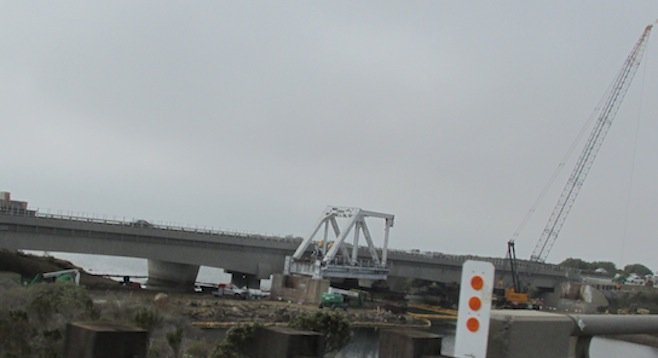 Facebook
Facebook
 X
X
 Instagram
Instagram
 TikTok
TikTok
 Youtube
Youtube

Motorists traveling northbound on I-5 through Camp Pendleton have probably noticed the slow disappearance of the old, rusty, white railroad bridge over the Santa Margarita River. The Atchison, Topeka, and Santa Fe Railway Company built the arched truss design in 1927. Until recently, it recently served up to 30 trains per day.
Since November 18, when Amtrak, Metrolink, and freight trains were diverted to the newly built, double tracked, river-crossing bridge, work crews have been torch-cutting the old bridge, removing one component at a time.
The old Santa Margarita Bridge may have been one of the last 1920s style bridges built for Southern California’s trains and highways — at least one of the last ones that was still in use. Several old steel bridges of historical significance, such as along Route 66, have been preserved, but not for everyday travel.
According to SANDAG spokesperson Helen Gao, the bridge weighed almost 1000 tons. A 300-ton-rated crane is being used to lift the pieces out of the riverbed. The final section (pictured) is probably completely gone by now. The old steel is being trucked to a recycling yard in Long Beach.
SANDAG, with a goal of increasing train usage by double-tracking San Diego’s entire coastal rail corridor, funded and constructed the bridge’s replacement. The old, single-track bridge was a train-traffic logjam for north- and southbound commuters. The North County Transit District owns the tracks, although its Coaster trains do not travel north of Oceanside.
Prior to the steel bridge’s construction in 1927, the older wooden-style trestle bridge, on more than one occasion, was wiped out by heavy flooding, isolating San Diego train travel from both Los Angeles and the San Bernardino/Riverside areas.
However, several of the old, wooden-trestle-style train bridges are still in use and can be seen crossing the San Dieguito River at the Del Mar Fairgrounds, the San Elijo Lagoon in Cardiff by the Sea, and the popular surf spot in Northern San Diego County named after the bridge’s design — Trestles.


Motorists traveling northbound on I-5 through Camp Pendleton have probably noticed the slow disappearance of the old, rusty, white railroad bridge over the Santa Margarita River. The Atchison, Topeka, and Santa Fe Railway Company built the arched truss design in 1927. Until recently, it recently served up to 30 trains per day.
Since November 18, when Amtrak, Metrolink, and freight trains were diverted to the newly built, double tracked, river-crossing bridge, work crews have been torch-cutting the old bridge, removing one component at a time.
The old Santa Margarita Bridge may have been one of the last 1920s style bridges built for Southern California’s trains and highways — at least one of the last ones that was still in use. Several old steel bridges of historical significance, such as along Route 66, have been preserved, but not for everyday travel.
According to SANDAG spokesperson Helen Gao, the bridge weighed almost 1000 tons. A 300-ton-rated crane is being used to lift the pieces out of the riverbed. The final section (pictured) is probably completely gone by now. The old steel is being trucked to a recycling yard in Long Beach.
SANDAG, with a goal of increasing train usage by double-tracking San Diego’s entire coastal rail corridor, funded and constructed the bridge’s replacement. The old, single-track bridge was a train-traffic logjam for north- and southbound commuters. The North County Transit District owns the tracks, although its Coaster trains do not travel north of Oceanside.
Prior to the steel bridge’s construction in 1927, the older wooden-style trestle bridge, on more than one occasion, was wiped out by heavy flooding, isolating San Diego train travel from both Los Angeles and the San Bernardino/Riverside areas.
However, several of the old, wooden-trestle-style train bridges are still in use and can be seen crossing the San Dieguito River at the Del Mar Fairgrounds, the San Elijo Lagoon in Cardiff by the Sea, and the popular surf spot in Northern San Diego County named after the bridge’s design — Trestles.